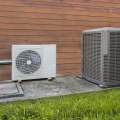When it comes to replacing an air conditioner, it is not always necessary to install a new set of pipes. Professional technicians will inspect the line and consider the specifications of the new system to make an accurate decision. The differences between refrigerants are not only limited to the use of chlorine, but they also contain different oils that don't mix well with each other. For example, R-22 contains a mineral oil that does not mix with POE oil, which is found inside the R-410 refrigerant in modern air conditioning units.
If an R-410 refrigerant is used through a set of pipes that carried the R-22 at one point, this can cause damage to the entire system and reduce the lifespan of the outdoor compressor. Therefore, using a new set of lines avoids the possibility of the oils being mixed together. While old sets of lines containing R-22 can be purged, there is evidence to show that washing a set of R-22 lines for air conditioning systems does not remove all remaining oil, which can lead to system failures in the future. This means that the most recommended approach when installing a new air conditioning system and replacing an old one is to use a new set of lines. You don't necessarily need to replace it if it's the right size and reused properly.
It's never a bad idea, but it's not always necessary, unless it's in bad shape, the wrong size, or a compressor has burned out. Thousands of systems reuse sets of lines without any issues. In fact, Carrier does not even recommend replacing them in its documentation, and there is no manufacturer that requires it. Good nitrogen purge (or discharge), vacuum, and pressure control are sufficient if done correctly. However, when replacing an air conditioner, it is important to consider all factors before making a decision. If you are unsure whether or not you need to install a new set of lines for your air conditioner replacement project, it is best to consult with a professional technician who can assess your system and provide you with an accurate recommendation.


